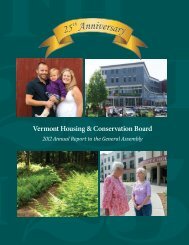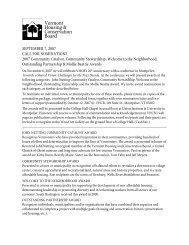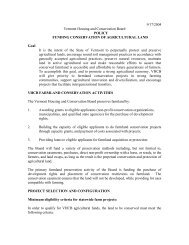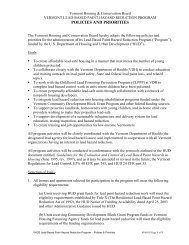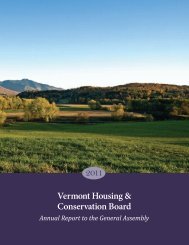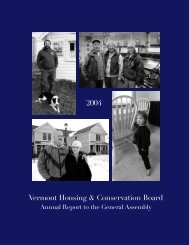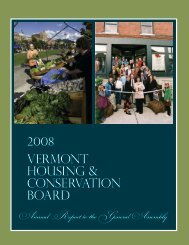Vermont Housing Conservation Board 2005 - Vermont Housing and ...
Vermont Housing Conservation Board 2005 - Vermont Housing and ...
Vermont Housing Conservation Board 2005 - Vermont Housing and ...
Create successful ePaper yourself
Turn your PDF publications into a flip-book with our unique Google optimized e-Paper software.
This joins a mix of new <strong>and</strong> retrofitted<br />
buildings at the Champlain Orchards<br />
farmstead that now also house a cider<br />
mill, cold storage room, <strong>and</strong> packing<br />
facility.<br />
Until now, <strong>Vermont</strong> apples destined<br />
for peeling have been sent<br />
to New York state. As Champlain<br />
Orchards develops the capacity to<br />
store, peel, <strong>and</strong> process apples on the<br />
farm, Suhr is working with state government<br />
to promote fresh apple slices<br />
for distribution to <strong>Vermont</strong> schools.<br />
“Studies have shown that kids will<br />
eat 40 percent more fruit when they<br />
consume slices,” he reports.<br />
Champlain Orchards is also the<br />
sole supplier of peeled slices to the<br />
<strong>Vermont</strong> Mystic Pie Company, an<br />
emerging Stowe-based business that<br />
has begun to market its top-quality<br />
apple pies up <strong>and</strong> down the East<br />
Coast, with the aim of exp<strong>and</strong>ing<br />
nationally. Champlain Orchards’ sales<br />
to Mystic Pie made up just one percent<br />
of its business last year, says Suhr<br />
— but may account for ten percent of<br />
its business in 2006.<br />
“I would like to store a variety of<br />
fantastic New Engl<strong>and</strong> apples that<br />
would entice people to shop locally<br />
year-round,” adds Suhr, who has<br />
begun to buy apples from four neighboring<br />
producers. “A <strong>Vermont</strong> grower<br />
does not have to sell his whole crop<br />
to a broker in New York if he knows<br />
that he will have a buyer locally yearround.<br />
“There is opportunity out there for<br />
all of us, young <strong>and</strong> old growers. We<br />
know how to grow fruit — <strong>and</strong> we are<br />
trying to take each step above that.<br />
It takes a lot of coordination, a lot of<br />
investment; but in the long haul, we<br />
are very self-sufficient.”<br />
BROWN FARM, RANDOLPH CENTER<br />
(continued from page 27)<br />
organic production. Christine was<br />
producing vegetables <strong>and</strong> ornamental<br />
plants in a modest-sized<br />
greenhouse on the farm.<br />
“Our main focus is to produce<br />
a quality produce in anything we<br />
do,” Christine says. “Our goal was<br />
to increase the value of our product,<br />
without enlarging our farm or our<br />
number of animals. In the first year<br />
with the Intervale process, one of<br />
our goals was to exp<strong>and</strong> my markets<br />
in the greenhouse business.<br />
“I’d done that business for a<br />
couple of years, <strong>and</strong> I knew the piece<br />
I was missing was marketing,” she<br />
says. “Typically, that’s the skill farmers<br />
lack. We’ve been pretty good at<br />
tracking our financials, but there’s<br />
always room for improvement — <strong>and</strong><br />
with the transitioning to organic, it’s<br />
a whole different ballgame.”<br />
Working with the Intervale <strong>and</strong><br />
NOFA-VT, the Browns created a<br />
business plan <strong>and</strong> a marketing plan,<br />
coupled with production <strong>and</strong> financial<br />
analysis. The plans called for a<br />
second greenhouse, so that Christine<br />
could exp<strong>and</strong> her ornamentals business<br />
<strong>and</strong> take advantage of a local<br />
dem<strong>and</strong> for early-season vegetables.<br />
Cost overruns had kept the Browns<br />
from completing the full greenhouse<br />
that Christine needed for optimum<br />
produce quality.<br />
This year, the family was granted<br />
an Implementation Award, a new<br />
feature of the Farm Viability Program.<br />
“The grant helped us finish raised<br />
beds, to start the early vegetables<br />
this coming spring,” Christine says.<br />
“It also enabled us to put in insula-<br />
The Browns were named <strong>2005</strong> Farm<br />
Family of the Year by the <strong>Vermont</strong> Farm<br />
Bureau.<br />
tion, to reduce energy costs, <strong>and</strong><br />
drip irrigation to reduce labor costs.”<br />
Her plants are now sold both<br />
on-farm <strong>and</strong> through the Hanover<br />
Food Co-op stores in Hanover <strong>and</strong><br />
Lebanon, N.H.<br />
“Farming’s such a labor-intensive<br />
operation that there’s not always<br />
time to explore the skills you need<br />
to make improvements,” Christine<br />
reflects. “The thing I like about the<br />
Viability Program is that it’s oneon-one.<br />
You can formulate a plan<br />
that’s custom-tailored, so I think the<br />
money is more efficient in helping,<br />
<strong>and</strong> the long-term effect is better.<br />
“Now,” she adds, “I can concentrate<br />
on quality.” That focus has not<br />
gone unrecognized: In <strong>2005</strong>, the<br />
Browns were named Farm Family<br />
of the Year by the <strong>Vermont</strong> Farm<br />
Bureau.<br />
29



